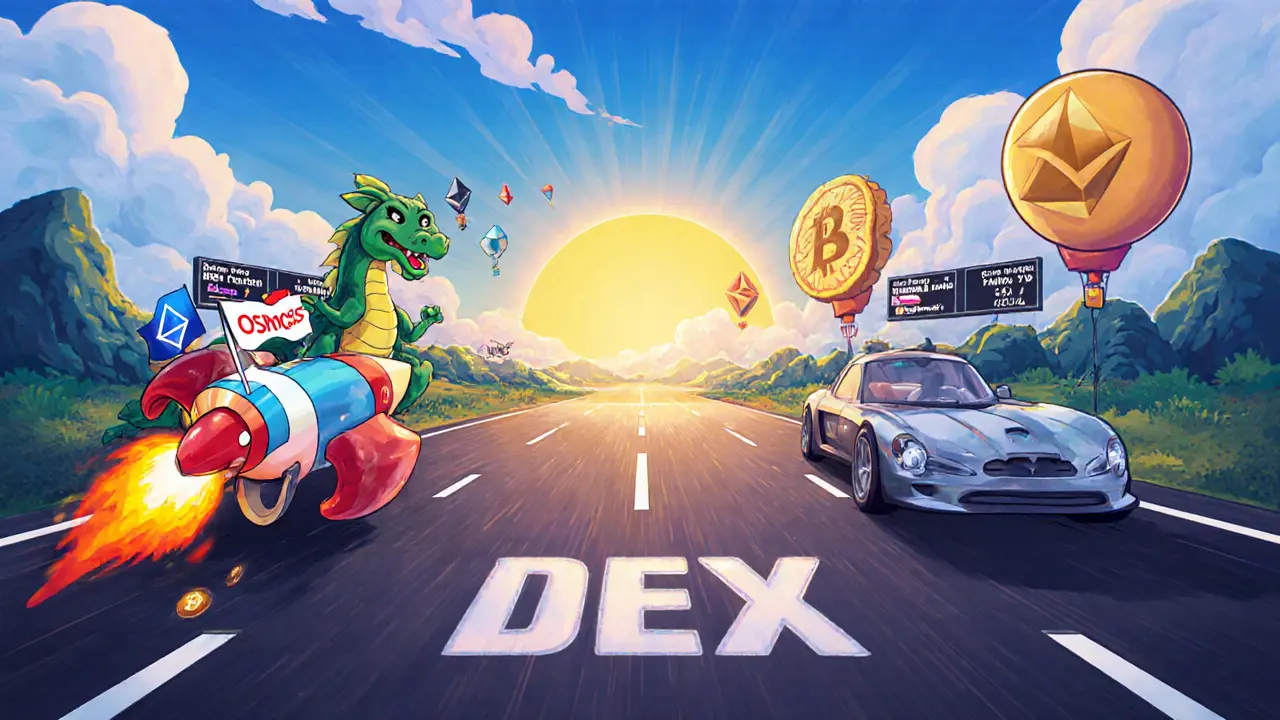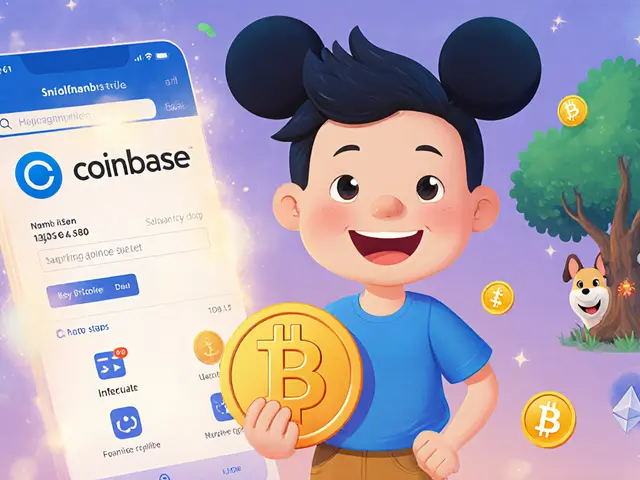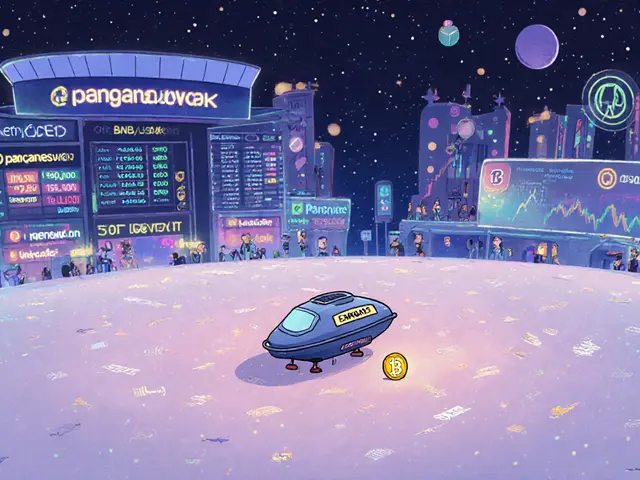Osmosis Fee Calculator
Estimated Transaction Costs
When you hear the name Osmosis is a decentralized exchange (DEX) built for the Cosmos ecosystem that lets users swap, earn, and govern across multiple blockchains via IBC, you probably wonder whether it lives up to the hype. This Osmosis review walks you through the platform’s core tech, user experience, fees, token economics, and how it compares with the big‑room DEXs you already know.
Quick Takeaways
- Specialized for Cosmos, offering the smoothest IBC swaps in the market.
- TVL around $150million in 2025 - modest vs Ethereum DEXs but dominant within Cosmos.
- Low fees (≈0.3% on swaps) and a flexible AMM model.
- OSMO token powers governance; price is volatile, trading near $0.20 in late 2025.
- User‑friendly UI, strong community, but limited token range outside Cosmos.
What Makes Osmosis Different?
Most DEXs you’ve tried-Uniswap, PancakeSwap, Curve-run on Ethereum or BNB‑Smart‑Chain. Osmosis, by contrast, Cosmos uses the Inter‑Blockchain Communication (IBC) protocol to let assets move freely between independent blockchains without a central bridge.
Key technical quirks:
- Weighted liquidity pools let you set your own token ratios, unlike the fixed 50/50 model on many AMMs.
- Governance proposals are voted on with the native OSMO token, giving active users a real say in fee structures and new features.
- Transaction fees are paid in the native token of the source chain (usually ATOM or OSMO), keeping costs under 0.5% for most swaps.
Getting Started: Step‑by‑Step
- Install a Cosmos‑compatible wallet. Keplr is the most popular and works directly in Chrome.
- Fund the wallet with a small amount of ATOM or OSMO to cover gas fees.
- Navigate to app.osmosis.zone and click “Connect Wallet”.
- Select the assets you want to swap, adjust slippage tolerance (default 0.5% works for most trades), and confirm.
- If you want to earn, click “Pools”, add liquidity, and receive LP tokens that accrue fees and governance voting power.
The whole process usually takes under three minutes for a first‑time user.
Fees, Liquidity, and Security
Osmosis charges a flat 0.3% fee on swaps, a portion of which goes to liquidity providers and the rest into a protocol‑wide treasury. Compared to Ethereum’s typical 0.25‑0.3% plus gas, the total out‑of‑pocket cost is often half because Cosmos chains have dramatically cheaper blockspace.
Security-wise, the DEX is open‑source and audited annually by third‑party firms. Since there’s no central custodial account, you retain full control of your private keys. The biggest risk comes from smart‑contract bugs-nothing unique to Osmosis-but the active developer community patches issues quickly.

OSMO Token: Utility and Performance
The OSMO token serves three purposes:
- Governance voting (changing fee rates, adding new pools).
- Staking for liquidity providers to boost rewards.
- Paying a small portion of transaction fees when the network opts for OSMO‑based fees.
Launched at $5.12 in October2021, OSMO peaked at $11.21 in March2022, then fell to $0.68 during the 2022 market dip. As of October2025 it trades near $0.20, reflecting the broader crypto market correction. Forecasts vary widely-from Capital.com’s $5.67 average in 2025 to TradersUnion’s bearish $0.32 target-so treat OSMO as a high‑risk, high‑potential governance token.
How Osmosis Stacks Up Against the Competition
| Metric | Osmosis | Uniswap | PancakeSwap | Curve |
|---|---|---|---|---|
| TVL | $150M (Cosmos‑focused) | $4B+ | $2B+ | $4B+ |
| Average Swap Fee | 0.30% | 0.25% + gas (≈$5‑$15) | 0.25% + gas (≈$0.5‑$2) | 0.04% (stablecoins only) |
| Supported Chains | Cosmos SDK + IBC assets | Ethereum + L2s | BNB‑Smart‑Chain + few EVMs | Ethereum + L2s (stablecoins) |
| Best For | Cosmos traders needing cheap cross‑chain swaps | Broad ERC‑20 ecosystem | Low‑cost BNB‑Chain swaps | Stablecoin yields |
In short, Osmosis shines when you’re dealing with Cosmos assets or need IBC‑enabled swaps. If you’re chasing deep liquidity on major tokens like ETH or USDC, Ethereum‑based DEXs still win.
Community, Governance, and Development Activity
The platform’s community is unusually vocal. Weekly governance polls attract thousands of votes, and the “most active Cosmos chain for governance” label is frequently highlighted in community newsletters. Founder Jae Kwon praised the launch as "the best moment in Cosmos," underscoring the importance of user‑centric design.
From a development standpoint, Osmosis ships feature updates almost every month-new pool types, improved UI themes, and better node‑running tooling. This pace rivals the busiest Ethereum projects and keeps the protocol fresh.
Regulatory Landscape
As of 2025, Osmosis operates without a formal regulatory license. This lack of oversight aligns with DeFi’s decentralization ethos but raises questions for institutional users who need compliance guarantees. The risk is mostly reputational; should a major jurisdiction crack down on unregistered DEXs, Osmosis could face indirect pressure (e.g., wallet providers disabling connections).

Pros & Cons Summary
- Pros: Lowest fees for Cosmos swaps, intuitive UI, strong governance, active dev team, deep integration with IBC.
- Cons: Limited token breadth outside Cosmos, smaller TVL means less depth for large trades, regulatory gray area.
Is Osmosis Right for You?
If you already hold ATOM, OSMO, or other Cosmos SDK tokens, Osmosis is almost certainly the cheapest and smoothest way to trade. Newcomers looking for a one‑stop shop for all crypto will probably start on Uniswap or PancakeSwap and later explore Osmosis as their Cosmos exposure grows.
Frequently Asked Questions
How do I connect a wallet to Osmosis?
Install the Keplr extension, create or import a Cosmos wallet, fund it with ATOM or OSMO for gas, then click “Connect Wallet” on app.osmosis.zone.
What fees will I pay when swapping?
A flat 0.30% fee is taken from each swap. In addition, the source chain’s native gas fee (usually a fewcents) is deducted.
Can I earn yield on Osmosis?
Yes. Provide liquidity to pools, earn a share of swap fees, and stake the resulting LP tokens for extra OSMO rewards.
Is Osmosis safe for large trades?
The protocol is audited and open‑source, but its TVL is modest. Very large orders may experience higher slippage compared to deep‑liquidity DEXs like Uniswap.
What is the role of the OSMO token?
OSMO is used for governance voting, staking rewards, and paying a portion of transaction fees. Holding OSMO also grants voting power in protocol upgrades.
Next Steps & Troubleshooting
For newcomers, start by swapping a small amount of ATOM for OSMO to get a feel for the UI. If a transaction fails, check the gas balance of your source chain and adjust the slippage tolerance. Persistent failures may indicate a temporary network congestion on the source chain; waiting a few minutes usually resolves it.
Advanced users can explore custom pool configurations: set asymmetric token ratios, add incentivized rewards, or propose a governance change via the on‑chain voting portal.
Whether you’re a DeFi hobbyist or a Cosmos developer, Osmosis offers the most polished gateway into cross‑chain trading today. Keep an eye on upcoming IBC‑v2 upgrades-they promise even faster swaps and broader asset support, which could tip the scales further in Osmosis’s favor.






Andrew Lin
Osmosis is a joke compared to real dexs.
Caitlin Eliason
Seeing how Osmosis frames governance as a playground for token whales feels like a betrayal of the DeFi ethos 🌐. The platform touts “community control,” yet the voting power is tightly bound to OSMO holdings, which skews decisions toward the biggest holders. Moreover, the lack of any regulatory oversight makes it a breeding ground for unchecked experiments 🚀. While the IBC integration is technically impressive, the user experience still feels like a beta version that hasn't been sanitized for everyday folks. In short, the hype eclipses the real risks that many casual traders overlook.
Franceska Willis
Yo fam, you gotta admit the weighted pools on Osmosis are a game‑changer, letting you tilt ratios like a DJ remixing a track. But the UI still throws cryptic error messages when you slip the slippage too low, which can leave newbies stranded. Also, the fee display sometimes mis‑calculates on exotic IBC pairs – I saw a 1.2% charge when the fee should've been 0.3%.
Nicholas Kulick
Osmosis positions itself as the premier DEX for the Cosmos ecosystem, and that claim warrants a thorough examination.
First, the weighted liquidity pool model is a notable innovation, allowing liquidity providers to allocate capital according to their risk appetite rather than being forced into a static 50/50 split.
This flexibility can improve capital efficiency, especially for assets with disparate volatility profiles.
Second, the fee structure, a flat 0.3% on swaps, is transparent and competitive when compared to the variable fees on many EVM‑based platforms.
Because transaction fees are paid in the native gas token of the source chain, users often pay only a few cents in gas, which dramatically lowers the total cost of entry.
However, the modest total value locked-around $150 million-means that large orders can suffer noticeable slippage, a factor that traders accustomed to Uniswap's deep liquidity must consider.
The governance model, driven by OSMO token holders, does empower active participants but also centralizes influence among the top holders, which can lead to proposals that favor insiders.
Security audits are conducted annually, and the open‑source nature of the codebase invites community scrutiny, yet no protocol is immune to exploitable bugs.
In practice, the most common incidents involve front‑running attacks that exploit the time lag between transaction submission and execution.
Mitigation strategies, such as using higher slippage tolerances or submitting smaller orders, can reduce exposure but also increase the effective cost of trading.
From a user experience perspective, the Keplr wallet integration streamlines onboarding, but the necessity of holding ATOM or OSMO for gas may pose an additional barrier for newcomers.
The platform’s UI is clean and responsive, though occasional latency spikes during network congestion can impair the swapping flow.
Looking ahead, the upcoming IBC‑v2 upgrades promise faster finality and broader asset support, which could address some of the current throughput limitations.
If those upgrades materialize as scheduled, Osmosis may capture a larger share of cross‑chain activity, especially as more projects adopt the Cosmos SDK.
Until then, users should weigh the low fees and innovative pool mechanics against the relative shallowness of liquidity and the governance concentration when deciding whether Osmosis fits their trading strategy.
Heather Zappella
For anyone just stepping into the Cosmos world, Osmosis offers a uniquely localized experience that feels like a cultural exchange rather than a sterile exchange platform. The integration of IBC bridges brings together communities from separate blockchains, fostering a sense of shared identity. If you’re curious about how governance proposals work, the on‑chain voting dashboard provides real‑time stats and historical data, making the process transparent. Additionally, the fee calculator embedded in the UI helps you anticipate costs before confirming a swap, which is especially helpful for newcomers who are still learning about gas dynamics. Overall, the platform serves as a gateway to the broader Cosmos ecosystem while maintaining a friendly learning curve.
Kate O'Brien
Did you notice that every time a big swap hits Osmosis, the fee treasury swells without any public audit? It feels like there’s a hidden layer that only the core devs see, and they might be funneling the extra profit elsewhere. Keep an eye on the transaction logs; the patterns are too consistent to be a coincidence. Simple reminder: stay skeptical and don’t dump all your tokens on one platform without checking the backdoor code.
Ricky Xibey
Just a heads‑up, the slippage slider defaults to 0.5% which works for most pairs, but if you’re moving a large chunk of ATOM you might want to bump it up a bit to avoid failed txs.
Sal Sam
From a protocol‑level perspective, the AMM utilizes a weighted constant‑product invariant, expressed as ∏_i (x_i)^{w_i} = k, where each weight w_i is user‑defined. This formulation allows asymmetric liquidity provisioning, effectively reducing impermanent loss for assets with disparate volatility curves. Moreover, the fee distribution algorithm allocates a proportion p of the swap fee to LPs based on their share of the pool’s total weighted capital, while the remainder feeds the on‑chain treasury for governance funding. These mechanics collectively enhance capital efficiency compared to a vanilla 50/50 pool.
Marcus Henderson
In light of the presented analysis, it is evident that Osmosis stands as a noteworthy contender within the decentralized finance landscape, particularly for users invested in the Cosmos ecosystem. Its fee structure and governance model offer both transparency and community participation, which are commendable attributes. While acknowledging the platform’s current limitations in liquidity depth, one may anticipate improvements as the IBC infrastructure evolves. Consequently, prospective participants are encouraged to explore Osmosis with a balanced perspective, recognizing both its strengths and areas for growth.
Melanie LeBlanc
Absolutely, the balanced outlook you provided helps newcomers focus on the positives without overlooking the risks. If you’re just getting started, try swapping a modest amount first to get a feel for the UI and fee timings. Pair that with a small liquidity provision in a well‑rated pool, and you’ll begin earning passive rewards while learning the governance process. Remember, consistency and patience are key in the DeFi journey.
Jasmine Kate
Honestly, the hype around Osmosis is just a circus parade that masks the fact that you’re basically paying the same fees as on any other DEX, just with a flashier UI. The weighted pools sound cool until you realize they don’t magically eliminate impermanent loss, they just shift the blame. And the governance token? Yeah, great for the whales, terrible for the rest of us. Bottom line: don’t be fooled by slick marketing.
Jason Wuchenich
While the criticism highlights real pain points, it’s also true that the community is actively iterating on solutions. Small improvements, like better slippage handling and more diverse pool options, are already on the roadmap. Keeping an open mind while staying vigilant can turn those shortcomings into learning opportunities.
Lara Decker
Someone needs to remember that not every token swap requires a deep dive; sometimes a quick trade is all you need.
Anna Engel
One could argue that the very notion of “decentralized exchange” has become a philosophical construct, a metaphor for the human desire to outsource trust, and Osmosis is merely the latest chapter in that literary saga.